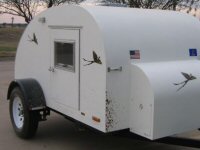Teardrop for One
21 posts
• Page 1 of 2 • 1, 2
Teardrop for One
This trailer will be built for a specific need and so it might not appeal to most people. It will be more of an overnight trailer than a camping trailer.
Why I'm Building This Tiny Trailer:
1. Living 2 hours from the nearest city there are times when I would like to attend evening functions there. But the 2 hour drive home late at night after the event often prevents me from going. A tiny trailer would allow me to stay overnight and drive back the next morning.
2. I often attend scheduled events that are 2 days driving distance away and I usually drive until late evening, leaving again first thing in the morning. A motel room for such a short stay seems wasteful. Plus, when I get to the event, being single, I’m often stuck in a bunkhouse with half a dozen men…can be noisy and there is a lack of privacy. A small trailer would be great.
3. And finally, I no longer enjoy tenting. I need a tiny trailer.
Needs list:
-- single bed (76” x 28” x 5” bed foam), raised 13” off floor.
-- 52” interior height, 48” is just too “crouchy” for me at 5’10”
-- small kitchen accessible from rear hatch; just a cooler, single burner stove, sink, water
-- porta-potti
-- trap-door shower (optional)
-- alcohol heater, electric blanket (powered from inverter in car)
-- towable with a small car (Like a Toyota Camry, Honda Civic, etc.)
-- small awning and fold-down table for road side lunch stops
-- roll-away small table for a laptop computer, etc.
-- insulated to 0 deg F.
-- easy to build
-- self-contained so that a campground is not required
-- “Home-Depot” parts throughout as much as possible
What I have in mind:
Because there is only a single bed, a 48” wide trailer will be adequate. The length need only be around 7 feet.
I’ll build on a trailer that is similar to a Red Trailer SJ-8530. Because it’s a bolt-together I can modify it to fit my purpose. It’s 4’ x 8’. The drawbar extends 41” beyond the frame so the front of the shell can overextend the frame by 11”, effectively moving the axle back that amount. The frame behind the axle will be shortened so that I end up with a shell that’s approximately 90” long by 52” wide (OD).
The underside of the trailer frame will be insulated with Styrofoam and covered with coroplast.
The shell will be a hybrid of plywood, wooden posts/beams/spars, foam, and canvas. It’ll be built from the inside out.
The interior walls will be installed first; thin plywood bolted directly to the sides of the trailer frame and trimmed to the shape of the trailer. Corner posts, door posts, roof beams, and edge trim are attached to the outside of the plywood (but fastened with screws from the inside) and follow the contour of the shell and fenders. Corner posts, door posts, and edge trim are built-up (glued) lengths of 1.5 x 3/4" clear lumber. The roof spars go into notches cut into the roof beams. The walls will be fitted with sheets of 1.5 inch Styrofoam that fit between the posts, and the gaps between the roof spars fitted with foam blocks. Finally, fabricate the door and hatch; then cover the exterior with canvas, glue, and paint. §
Why I'm Building This Tiny Trailer:
1. Living 2 hours from the nearest city there are times when I would like to attend evening functions there. But the 2 hour drive home late at night after the event often prevents me from going. A tiny trailer would allow me to stay overnight and drive back the next morning.
2. I often attend scheduled events that are 2 days driving distance away and I usually drive until late evening, leaving again first thing in the morning. A motel room for such a short stay seems wasteful. Plus, when I get to the event, being single, I’m often stuck in a bunkhouse with half a dozen men…can be noisy and there is a lack of privacy. A small trailer would be great.
3. And finally, I no longer enjoy tenting. I need a tiny trailer.
Needs list:
-- single bed (76” x 28” x 5” bed foam), raised 13” off floor.
-- 52” interior height, 48” is just too “crouchy” for me at 5’10”
-- small kitchen accessible from rear hatch; just a cooler, single burner stove, sink, water
-- porta-potti
-- trap-door shower (optional)
-- alcohol heater, electric blanket (powered from inverter in car)
-- towable with a small car (Like a Toyota Camry, Honda Civic, etc.)
-- small awning and fold-down table for road side lunch stops
-- roll-away small table for a laptop computer, etc.
-- insulated to 0 deg F.
-- easy to build
-- self-contained so that a campground is not required
-- “Home-Depot” parts throughout as much as possible
What I have in mind:
Because there is only a single bed, a 48” wide trailer will be adequate. The length need only be around 7 feet.
I’ll build on a trailer that is similar to a Red Trailer SJ-8530. Because it’s a bolt-together I can modify it to fit my purpose. It’s 4’ x 8’. The drawbar extends 41” beyond the frame so the front of the shell can overextend the frame by 11”, effectively moving the axle back that amount. The frame behind the axle will be shortened so that I end up with a shell that’s approximately 90” long by 52” wide (OD).
The underside of the trailer frame will be insulated with Styrofoam and covered with coroplast.
The shell will be a hybrid of plywood, wooden posts/beams/spars, foam, and canvas. It’ll be built from the inside out.
The interior walls will be installed first; thin plywood bolted directly to the sides of the trailer frame and trimmed to the shape of the trailer. Corner posts, door posts, roof beams, and edge trim are attached to the outside of the plywood (but fastened with screws from the inside) and follow the contour of the shell and fenders. Corner posts, door posts, and edge trim are built-up (glued) lengths of 1.5 x 3/4" clear lumber. The roof spars go into notches cut into the roof beams. The walls will be fitted with sheets of 1.5 inch Styrofoam that fit between the posts, and the gaps between the roof spars fitted with foam blocks. Finally, fabricate the door and hatch; then cover the exterior with canvas, glue, and paint. §
Last edited by Henry Benner on Sun Sep 20, 2015 10:50 am, edited 3 times in total.
-

Henry Benner - Teardrop Inspector
- Posts: 20
- Images: 10
- Joined: Fri Feb 23, 2007 9:08 am
- Location: SW Alberta Canada
Re: Teardrop for One
I think you have a solid plan. What width trailer are you making ? Have you considered a drop floor just inside the door. Allows you to set on the bed and put your feet in the well. Also helps with a porta pottie, it can use the same drop floor.
-

Woodbutcher - Platinum Donating Member
- Posts: 4191
- Images: 45
- Joined: Fri Mar 10, 2006 10:01 pm
- Location: Chicago Suburbs




 We all love pictures. Great lines
We all love pictures. Great lines

